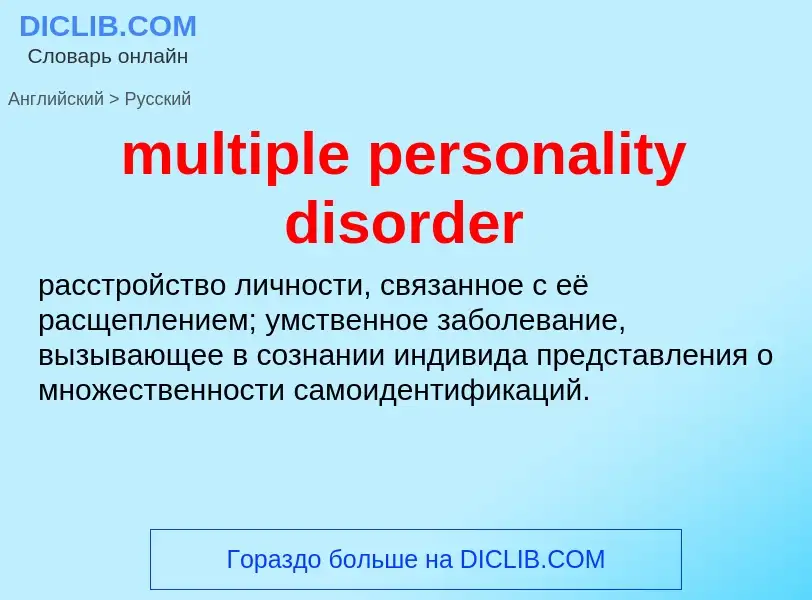Tradução e análise de palavras por inteligência artificial ChatGPT
Nesta página você pode obter uma análise detalhada de uma palavra ou frase, produzida usando a melhor tecnologia de inteligência artificial até o momento:
- como a palavra é usada
- frequência de uso
- é usado com mais frequência na fala oral ou escrita
- opções de tradução de palavras
- exemplos de uso (várias frases com tradução)
- etimologia
multiple personality disorder - tradução para russo
общая лексика
прямой входной набор
метод входной маршрутизации факс-сервера
автоматическое установление входящего соединения, прямой набор внутренних (телефонных) номеров
в телефонии - функция, позволяющая входящему вызову из сети общего пользования достичь определенного абонента внутри офиса без содействия оператора
автоматическое установление соединения с абонентом УАТС
сокращение
direct inward dialling
синоним
Смотрите также
существительное
общая лексика
прямой входной набор
синоним
Wikipédia
Dissociative identity disorder (DID), formerly known as multiple personality disorder, and commonly referred to as split personality disorder or dissociative personality disorder, is a member of the family of dissociative disorders classified by the DSM-5, DSM-5-TR, ICD-10, ICD-11, and Merck Manual for diagnosis. It remains a controversial diagnosis.
Dissociative identity disorder is characterized by the presence of at least two distinct and relatively enduring personality states.(p331) The disorder is accompanied by memory gaps more severe than could be explained by ordinary forgetfulness.(p331) The personality states alternately show in a person's behavior;(p331) however, presentations of the disorder vary. Other conditions that often occur in people with DID include post-traumatic stress disorder, personality disorders (especially borderline, Schizotypal and avoidant), depression, substance use disorders, conversion disorder, somatic symptom disorder, eating disorders, obsessive–compulsive disorder, and sleep disorders.(pp333–338) Self-harm, non-epileptic seizures, flashbacks with amnesia for content of flashbacks, anxiety disorders, and suicidality are also common.
DID requires an unintegrated mind to form. Genetic and biological factors are also believed to play a role. The diagnosis should not be made if the person's condition is better accounted for by substance use disorder, seizures, other medical problems, imaginative play in children, or religious practices.(p331)
According to the DSM-5-TR, early life trauma, typically before the age of 10, can place someone at risk of developing dissociative identity disorder.(p334)Across diverse geographic regions, 90% of individuals diagnosed with dissociative identity disorder report experiencing multiple forms of childhood abuse, such as neglect or severe bullying.(p334) Other traumatic childhood experiences that have been reported include painful medical or surgical procedures,(p334) war,(p334) terrorism,(p334) attachment disturbance,(p334) natural disaster, cult and occult abuse, loss of a loved one or loved ones, human trafficking,(p334) and dysfunctional family dynamics.(p334)
There is no medication to treat DID directly. Medications can be used for comorbid disorders or targeted symptom relief, for example antidepressants or treatments to improve sleep, however. Treatment generally involves supportive care and psychotherapy. The condition usually persists without treatment. It is believed to affect about 1.5% of the general population (based on a small US community sample) and 3% of those admitted to hospitals with mental health issues in Europe and North America.(p334) DID is diagnosed about six times more often in women than in men. The number of recorded cases increased significantly in the latter half of the 20th century, along with the number of identities reported by those affected.
It is unclear whether increased rates of the disorder are due to better recognition or sociocultural factors such as mass media portrayals. The typical presenting symptoms in different regions of the world may also vary depending on culture, such as alter identities taking the form of possessing spirits, deities, ghosts, or mythical creatures and figures in cultures where normative possession states are common.(p335) The possession form of dissociative identity disorder is involuntary and distressing, and occurs in a way that violates cultural or religious norms.(p335)

![Pierre Marie Félix Janet]] (1859–1947), the philosopher and psychologist who first alleged a connection between events in the subject's past and present mental health, also coining the words "dissociation" and "subconscious" Pierre Marie Félix Janet]] (1859–1947), the philosopher and psychologist who first alleged a connection between events in the subject's past and present mental health, also coining the words "dissociation" and "subconscious"](https://commons.wikimedia.org/wiki/Special:FilePath/Plaque Pierre Janet, 54 rue de Varenne, Paris 7.jpg?width=200)
![One of ten photogravure portraits of [[Louis Vivet]] published in ''Variations de la personnalité'' by [[Henri Bourru]] and [[Prosper Ferdinand Burot]] One of ten photogravure portraits of [[Louis Vivet]] published in ''Variations de la personnalité'' by [[Henri Bourru]] and [[Prosper Ferdinand Burot]]](https://commons.wikimedia.org/wiki/Special:FilePath/Vivé.jpg?width=200)
